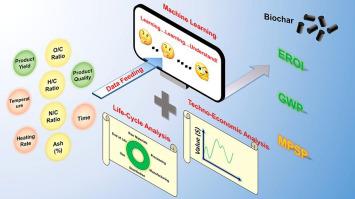当前位置:
X-MOL 学术
›
Energy Convers. Manag.
›
论文详情
Our official English website, www.x-mol.net, welcomes your
feedback! (Note: you will need to create a separate account there.)
Slow pyrolysis as a platform for negative emissions technology: An integration of machine learning models, life cycle assessment, and economic analysis
Energy Conversion and Management ( IF 9.9 ) Pub Date : 2020-11-01 , DOI: 10.1016/j.enconman.2020.113258 Fangwei Cheng , Hongxi Luo , Lisa M. Colosi
Energy Conversion and Management ( IF 9.9 ) Pub Date : 2020-11-01 , DOI: 10.1016/j.enconman.2020.113258 Fangwei Cheng , Hongxi Luo , Lisa M. Colosi

|
Abstract Biochar sequestration has gained increasing attention as a negative emissions technology to mitigate climate change. Although pyrolysis is a commercial technology, comprehensive environmental and economic assessments have been difficult to perform since biochar can be produced from a wide range of feedstocks and pyrolysis conditions. Many researchers have evaluated the environmental and economic impacts of biochar-based CO2 sequestration systems. However, most studies either worked on a single type of biomass under varying pyrolysis conditions or multiple feedstocks under the same pyrolysis conditions. To address this knowledge gap, we evaluated the energy, climate change, and economic performance of slow pyrolysis of multiple feedstocks under various processing conditions via the integration of machine learning approaches, life cycle assessment (LCA), and economic analysis. Machine learning models (i.e., random forest) were developed by fitting existing laboratory data. The models were then used to predict the yields and characteristics of biochar produced from slow pyrolysis of different feedstocks under designed processing conditions. The results were further integrated with LCA and economic analysis to compute three important metrics: energy return on investment (EROI), net global warming potential (GWP), and minimum product selling price (MPSP). The results indicate that random forest models offer good prediction accuracy for laboratory-scale (R2 = 0.78–0.87) and pilot-scale pyrolysis data (R2 = 0.45–0.65). LCA and economic analyses reveal that feedstock characteristics and pyrolysis temperature affect energy, climate change, and financial performance. Our results demonstrate slow pyrolysis of crop residues and woody wastes holds promise as an energy-producing negative emissions technology, with EROI values from 1.9 to 3.6 (without substitution) and 2.4 to 4.3 (with substitution), and GWP values from −470 kg CO2 eq/t to −200 kg CO2 eq/t (without substitution) and −1050 kg CO2 eq/t to −770 kg CO2 eq/t (with substitution). The MSPS values evaluated in this study range from $774–1256/t, depending on temperature and feedstocks. A tradeoff between environmental and economic performance is observed. The best overall energy and climate change performances are achieved via pyrolysis of lignocellulosic biomass at high temperature, while the best MPSP is achieved with the pyrolysis of sludge at low temperature.
中文翻译:

慢热解作为负排放技术平台:机器学习模型、生命周期评估和经济分析的集成
摘要 生物炭封存作为一种减缓气候变化的负排放技术受到越来越多的关注。尽管热解是一项商业技术,但由于生物炭可以从各种原料和热解条件中生产,因此很难进行全面的环境和经济评估。许多研究人员评估了基于生物炭的 CO2 封存系统的环境和经济影响。然而,大多数研究要么在不同的热解条件下研究单一类型的生物质,要么在相同的热解条件下对多种原料进行研究。为了解决这一知识差距,我们通过整合机器学习方法评估了多种原料在各种加工条件下缓慢热解的能源、气候变化和经济性能,生命周期评估 (LCA) 和经济分析。机器学习模型(即随机森林)是通过拟合现有的实验室数据而开发的。然后使用这些模型来预测不同原料在设计的加工条件下缓慢热解产生的生物炭的产量和特性。结果进一步与 LCA 和经济分析相结合,以计算三个重要指标:能源投资回报率 (EROI)、净全球变暖潜能值 (GWP) 和最低产品销售价格 (MPSP)。结果表明,随机森林模型为实验室规模(R2 = 0.78-0.87)和中试规模的热解数据(R2 = 0.45-0.65)提供了良好的预测精度。LCA 和经济分析表明,原料特性和热解温度会影响能源、气候变化和财务绩效。我们的结果表明,作物残留物和木质废料的缓慢热解有望作为一种产生能量的负排放技术,其 EROI 值为 1.9 至 3.6(无替代)和 2.4 至 4.3(有替代),GWP 值为 -470 kg CO2 eq/t 至 -200 kg CO2 eq/t(无替代)和 -1050 kg CO2 eq/t 至 -770 kg CO2 eq/t(有替代)。本研究中评估的 MSPS 值范围为 $774–1256/t,具体取决于温度和原料。观察到环境和经济性能之间的权衡。最好的整体能源和气候变化性能是通过木质纤维素生物质在高温下的热解实现的,而最好的 MPSP 是通过污泥在低温下的热解实现的。
更新日期:2020-11-01
中文翻译:

慢热解作为负排放技术平台:机器学习模型、生命周期评估和经济分析的集成
摘要 生物炭封存作为一种减缓气候变化的负排放技术受到越来越多的关注。尽管热解是一项商业技术,但由于生物炭可以从各种原料和热解条件中生产,因此很难进行全面的环境和经济评估。许多研究人员评估了基于生物炭的 CO2 封存系统的环境和经济影响。然而,大多数研究要么在不同的热解条件下研究单一类型的生物质,要么在相同的热解条件下对多种原料进行研究。为了解决这一知识差距,我们通过整合机器学习方法评估了多种原料在各种加工条件下缓慢热解的能源、气候变化和经济性能,生命周期评估 (LCA) 和经济分析。机器学习模型(即随机森林)是通过拟合现有的实验室数据而开发的。然后使用这些模型来预测不同原料在设计的加工条件下缓慢热解产生的生物炭的产量和特性。结果进一步与 LCA 和经济分析相结合,以计算三个重要指标:能源投资回报率 (EROI)、净全球变暖潜能值 (GWP) 和最低产品销售价格 (MPSP)。结果表明,随机森林模型为实验室规模(R2 = 0.78-0.87)和中试规模的热解数据(R2 = 0.45-0.65)提供了良好的预测精度。LCA 和经济分析表明,原料特性和热解温度会影响能源、气候变化和财务绩效。我们的结果表明,作物残留物和木质废料的缓慢热解有望作为一种产生能量的负排放技术,其 EROI 值为 1.9 至 3.6(无替代)和 2.4 至 4.3(有替代),GWP 值为 -470 kg CO2 eq/t 至 -200 kg CO2 eq/t(无替代)和 -1050 kg CO2 eq/t 至 -770 kg CO2 eq/t(有替代)。本研究中评估的 MSPS 值范围为 $774–1256/t,具体取决于温度和原料。观察到环境和经济性能之间的权衡。最好的整体能源和气候变化性能是通过木质纤维素生物质在高温下的热解实现的,而最好的 MPSP 是通过污泥在低温下的热解实现的。











































 京公网安备 11010802027423号
京公网安备 11010802027423号